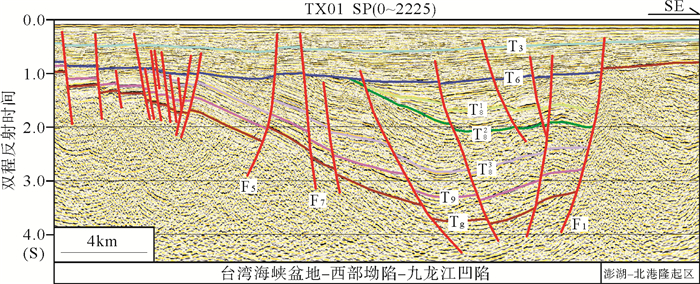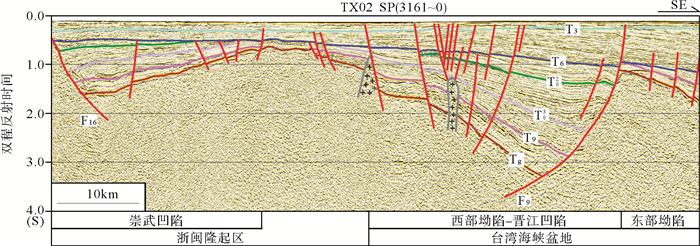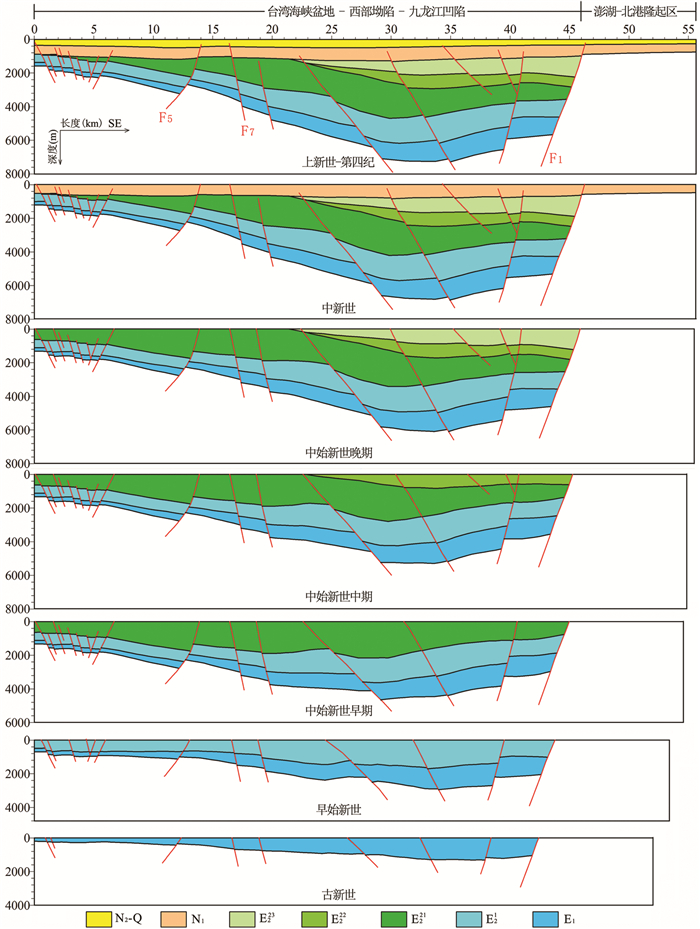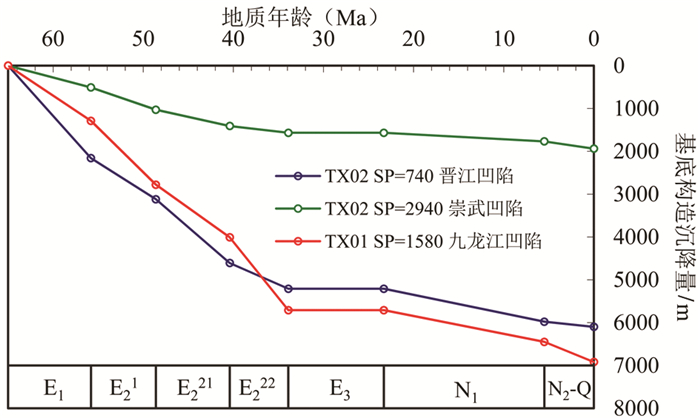Application of balanced cross section technique to the study of tectonic evolution of western Taiwan Strait Basin
-
摘要: 以台湾海峡盆地西部为研究对象,在地震资料构造解释的基础上,选取能控制区域构造格局的2条典型剖面,运用2D Move软件分别对其进行平衡剖面恢复,并计算出各剖面不同时期的伸展量、伸展率和伸展系数,初步计算各凹陷在不同时期的基底构造沉降量,以此为基础对台湾海峡盆地西部的构造演化过程及其区域性差异进行了定量研究。研究结果显示:(1)研究区的伸展强度和基底构造沉降量在始新世和中新世之间均急剧减小,反映渐新世是一个构造转换时期;(2)研究区在新生代表现为古新世至早始新世持续断陷作用—中始新世差异升降—始新世末至渐新世隆升剥蚀—中新世之后稳定缓慢坳陷沉积;(3)台湾海峡盆地在新生代大致经历了古新世-始新世断陷演化阶段、中新世坳陷演化阶段和上新世—第四纪前陆盆地演化阶段。Abstract: Taking the western Taiwan Strait Basin as the research subject, two large regional sections, which control the regional tectonic framework, are selected to restore balance sections using 2D Move software. The extension amount, the extensional ratio and the extensional coefficient are calculated, in addition to the preliminary calculation of structural subsidence amount of the basement for each sag in the research area. Upon the basis, the tectonic evolution process and its regional differentiation in Western Taiwan Strait Basin are quantitatively studied. The results suggest that: (1)Both extensional intensity and structural subsidence amount of basement are drastically decreased from Eocene to Miocene, indicating that Oligocene is a transitional period of tectonics; (2)There is continuous fault subsidence from Paleocene to early Eocene, differential uplifting in Middle Eocene and slow subsidence after Miocene in the research area; (3)Taiwan Strait Basin has experienced four stages of evolution i.e. fault subsidence from Paleocene to Eocene, depression in Miocene and fore-arc basin between Pliocene and Quaternary.
-
台湾海峡盆位于台湾海峡及其相邻的台湾西部山麓区,是古新世期间在继承白垩系裂陷的基础上发生进一步张裂而形成的陆缘裂陷,并于后期深受前陆作用影响的中、新生代叠合盆地[1, 2],具有较好的油气资源前景[3-9]。该盆地大地构造上位于菲律宾海板块和亚欧板块的交汇处,自盆地形成经历多期构造作用的叠加影响,蕴含了太平洋板块与欧亚大陆板块相互作用的重要信息。研究该盆地的构造特征和演化过程对探索该区域的石油地质条件及太平洋板块运动过程有着重要意义。前人对台湾海峡盆地的形成和演化做很多研究工作[1, 2, 5, 6, 10-13],主要针盆地的构造演化进行定性探讨,尤其缺乏定量研究。平衡剖面方法是定量研究断陷盆地演化过程的有效方法,被逐渐推广应用成为盆地构造恢复的基础和核心技术[14-23]。本文以研究区最新采集的二维多道地震资料为基础,运用2DMove软件对台湾海峡盆地西部的典型测线进行平衡剖面恢复,计算台湾海峡盆地西部各时期的拉张速率及沉积速率等参数,同时结合前人成果,研究其新生代的构造及沉积演化特征,探讨同一时期内研究区不同区带构造变形强度的差异,为该区今后的油气勘探工作提供基础地质依据。
1. 区域地质概况
台湾海峡盆地东以屈尺-荖浓断裂带为界,西部边界以断陷斜坡古近系地层尖灭线或断层与浙闽隆起区相隔,南以澎北断裂与澎湖-北港隆起相邻,北以观音隆起与东海陆架盆地相隔。盆地新生代沉积厚度较大,可分为西部坳陷与东部坳陷2个二级构造单元。根据主控断层及古近纪地层厚度变化等特征,在东部坳陷可进一步划分出新竹凹陷、苗栗凸起和台中凹陷3个三级构造单元;西部坳陷可进一步划分出九龙江凹陷、澎北凸起和晋江凹陷3个三级构造单元(图 1)。东部坳陷沉积中心位于新竹凹陷,最大沉积厚度超过8000m。西部坳陷沉积中心有2个,一个位于晋江凹陷,另一个位于九龙江凹陷,根据最新的地震资料解释结果,两凹陷最大沉积厚度超过7000m。
![]() 图 1 台湾海峡及邻区构造区划1-盆地或隆起区边界;2-坳陷边界;3-凹陷或凸起边界;4-正断层;5-断层或推测断层;6-平衡剖面位置;7-研究区;①屈尺-荖浓断裂;②义竹断裂Figure 1. Tectonic map of the Taiwan Strait1-boudary of basin or uplift area; 2-boudary of depression; 3-boudary of sag or high; 4-normal fault; 5-fault or Inferred fault; 6-position of balanced cross section; 7-research area; ①Quchi-Laonong fault; ②Yizhu fault
图 1 台湾海峡及邻区构造区划1-盆地或隆起区边界;2-坳陷边界;3-凹陷或凸起边界;4-正断层;5-断层或推测断层;6-平衡剖面位置;7-研究区;①屈尺-荖浓断裂;②义竹断裂Figure 1. Tectonic map of the Taiwan Strait1-boudary of basin or uplift area; 2-boudary of depression; 3-boudary of sag or high; 4-normal fault; 5-fault or Inferred fault; 6-position of balanced cross section; 7-research area; ①Quchi-Laonong fault; ②Yizhu fault本文的研究区主要涉及台湾海峡盆地的西部坳陷及其相邻的浙闽隆起区的部分区域(图 1)。据前人研究结果, 研究区的基底为与大南澳群(最老岩石为二叠纪)相当的片岩、大理岩, 盖层为白垩系和新生界[24]。根据钻井和地震资料对比解释结果,研究区新生界主要发育了古近纪、新近纪和第四纪沉积地层,从下往上依次为古新统(T9-Tg)、始新统(T6-T9,下始新统T83-T9、中始新统T6-T83)、中新统(T3-T6)、上新统-第四系(T0-T3)(图 2和图 3,表 1)。研究区古近系以古新统和始新统沉积为主,缺失渐新统,中新统和上新统-第四系较薄,这一特征有别于盆地的东部区域。研究区内断层以NE (NEE)向为主,近EW向断层次之,同时发育少量NW向断层。NE(NEE)向断层在研究区内占据主导地位,往往是盆地和凹陷构造单元的边界,控制其形成演化。
表 1 研究区地震层序与构造演化阶段划分表Table 1. Classification of seismic sequences and corresponding stages of tectonic evolution in research area
2. 平衡剖面恢复
2.1 典型剖面的选取
平衡剖面恢复研究主要应用于垂直构造走向或近垂直构造走向的剖面。研究区地表和近地表的构造线方向以NE(NEE)向为主,新生代以来以NW-SE向的张裂为主,所以选取能控制盆地基本构造格局的NW-SE向剖面TX01和TX02两条区域大剖面开展平衡剖面恢复研究。
TX01测线剖面长度55.6km,西北端始于浙闽隆起区南部边缘,向东南进入台湾海峡盆地九龙江凹陷。现今剖面总体表现为一受NWW向正断层控制的东断西掀半地堑形态;主干断层断距大,伴有岩体侵入作用;半地堑内部发育一系列NW和SE向的正断层。
TX02测线剖面长度79km,西北端始于崇武凹陷,向东南进入晋江凹陷。现今剖面显示,中部凸起,两端呈半地堑形态,两个半地堑地层倾向相反,分别由倾向相对、走向分别为NWW和NE向的正断层控制;两个半地堑边缘都发育有正向和反向正断层;东南端半地堑地层厚度相对较大,主干断层断距大,半地堑边缘有岩体侵入。
2.2 平衡剖面恢复与计算结果
平衡剖面技术是假定剖面上地层的变形符合平面应变条件,按照面积不变或长度不变的几何学平衡原则进行剖面的构造复原[25]。本文运用英国Midland Valley勘探有限公司2DMove软件进行平衡恢复。地层回剥时采用Airy模型进行均衡校正,参考前人的研究成果[26-29]。研究区内的断层均为正断层,在新生代地层断距恢复时采用斜剪切法;研究区在新生代主要为拉张环境,因此, 对新生代地层采用恢复至基准面法。由于研究区内在中始新世中期-中新世期间存在抬升区域,因此, 剥蚀量的恢复尤为重要。剥蚀量的恢复方法有声波时差法、镜煤反射率法、产状法、磷灰石径迹法等。鉴于研究区资料限制,本文采用最为直接有效的产状法,即根据地层趋势来补充剥蚀量。平衡剖面恢复结果如图 4、图 5所示。
通过对构造发育剖面的定量分析,并计算出各剖面不同时期的伸展量、伸展率和伸展系数(表 2,图 6),选取研究区内各凹陷的沉积中心部位,初步计算各凹陷在不同时期的基底构造沉降量(图 7),重点分析研究区横向伸展特征及纵向沉降速率变化特点,以此为基础对研究区构造演化过程及其区域性差异进行探讨。
表 2 TX01和TX02测线伸展特征参数Table 2. Extensional characteristic parameter of for line TX01 and TX02层位 TX01 TX02 L0(m) L1(m) ΔL e β L0(m) L1(m) ΔL e β T0-Tg 第四系 55600 55600 0 0 1 79000 79000 0 0 1 T3-Tg 上新统 55571 55600 29 0.0005 1.0005 78966 79000 34 0.0004 1.0004 T6-Tg 中新统 55441 55600 159 0.0029 1.0029 78521 79000 479 0.0061 1.0061 T82-Tg 中始新统 54530 55600 1070 0.0196 1.0196 77095 79000 1905 0.0247 1.0247 T83-Tg 下始新统 53352 55600 2248 0.0421 1.0421 72665 79000 6335 0.0872 1.0872 T9-Tg 古新统 51977 55600 3623 0.0697 1.0697 69265 79000 9735 0.1405 1.1405 注:L0为剖面原始长度;L1为经伸展构造变形后的长度;伸展量:ΔL=L1-L0;伸展率:e= (L1-L0)/L0,表示单位长度的地壳伸长量;伸展系数:β=L1/L0=1+e,表示伸展构造变形前、后地壳的长度比 2.2.1 古新世
白垩纪末-古新世初期,伸展活动开始,表现为发育一系列切割新生界基底的正断层,至古新世晚期,九龙江、晋江、崇武等凹陷初始形成。其中晋江凹陷和九龙江凹陷受NE断层控制,形成东断西超的半地堑;崇武凹陷受NW向断层控制;介于崇武凹陷和晋江凹陷的区域的澎北凸起此时也处于水下,但水体很浅,接受很薄的沉积;晋江凹陷南部的澎湖-北港隆起区为剥蚀区。TX01测线和TX02测线伸展率分别为6.97%和14.05%,反映研究区北部伸展作用要强于南部;基底沉降量和沉降速率方面,晋江凹陷都为最大,其次是九龙江凹陷,崇武凹陷最小。
2.2.2 始新世
早始新世,伸展作用进一步增强,九龙江凹陷、晋江凹陷和崇武凹陷接受早始新世地层沉积,这一时期在晋江凹陷中部和斜坡边缘发生岩浆侵入作用。早始新世TX01测线和TX02测线伸展率较古新世有所下降,分别为4.21%和8.72%,研究区北部的伸展作用仍大于南部。这一时期,九龙江凹陷和崇武凹陷的基底沉降速率稍有增大,而晋江凹陷基底沉降速率稍有减小,但基底沉降量仍为晋江凹陷>九龙江凹陷>崇武凹陷。
中始新世早期,3个凹陷构造格局基本不变,沉积范围进一步扩大,接受较厚的中始新世早期的地层沉积。中始新世早期TX01测线和TX02测线伸展率较早始新世下降明显,分别为1.96%和2.47%,研究区北部的伸展作用仍大于南部。这一时期,九龙江凹陷和崇武凹陷的基底沉降速率稍有减小,而晋江凹陷基底沉降速率稍有增大,基底沉降量仍为晋江凹陷>九龙江凹陷>崇武凹陷。
中始新世中期开始,研究区南北凹陷地层沉积开始出现差异,南部九龙江凹陷发生差异升降,其东部继续沉降,接受中始新世中期地层沉积;而其西部隆升遭受剥蚀,缺失该期地层沉积。北部的晋江凹陷和崇武凹陷未发生差异升降,仍继续沉降,接受中始新世中期地层沉积。这一时期,九龙江凹陷基底沉降速率迅速增大,而晋江凹陷的基底沉降速率稍有减小,这样九龙江凹陷基底沉降量首次超过晋江凹陷成为最大,晋江凹陷基底沉降量次之。崇武凹陷的基底沉降速率和基底沉降量仍为最小,其基底沉降速率较前期变化很小。
中始新世晚期,研究区南部九龙江凹陷继续保持前一阶段构造格局,发生差异升降,凹陷东部继续沉降,接受中始新世中期地层沉积;而凹陷西部继续隆升遭受剥蚀,缺失该期地层沉积。研究区北部在这一时期开始隆升,缺失该期地层沉积。
据区域地层及钻井资料分析,研究区于始新世晚期-渐新世遭受挤压,隆升遭受剥蚀,伴有中-基性岩和酸性岩侵入、喷发作用,缺失该时期沉积地层。根据TX01和TX02测线古新统-始新统地层趋势推算这一时期不同地区的剥蚀量,九龙江凹陷约为0~770m,晋江江凹陷约为0~170m,崇武凹陷约为0~130m,澎北凸起约为0~150m。
2.2.3 中新世
断层的活动性明显减弱,全区进入坳陷沉积阶段,全区普遍接受中新世地层披覆沉积,研究区南部TX01测线九龙江凹陷中心部位地层最厚,向两边稍微有所减薄;研究区北部TX02测线地层总体由西北端向东南端逐渐增厚,向东有继续增厚趋势。TX01测线和TX02测线伸展率急剧下降,分别为0.29%和0.61%,研究区北部的伸展作用仍大于南部。基底沉降速率方面,九龙江凹陷、晋江凹陷和崇武凹陷相差无几,均较始新世时期有明显降低;基底沉降量为九龙江凹陷>晋江凹陷>崇武凹陷。
2.2.4 上新世-第四纪
伸展活动基本停止,沉积基本不受伸展断层影响,全区接受上新世-第四纪地层披覆沉积,TX01测线和TX02测线伸展率进一步减小且非常接近,分别为0.05%和0.04%。基底沉降速率方面,九龙江凹陷和崇武凹陷较前期稍有增大,晋江凹陷则稍变小,但总体变化都不大;基底沉降量仍为九龙江凹陷>晋江凹陷>崇武凹陷。
3. 讨论
通过上述典型平衡剖面分析,在伸展强度方面,研究区北部的伸展强度自古新统至中新世一直大于南部,至上新世-第四纪南北两区伸展强度才趋于一致;始新世和中新世之间,研究区伸展率发生突变,南部和北部的伸展速率都急剧变小(南部TX01伸展速率由1.96%降至0.29%,北部的TX02由2.47%降至0.61%),反映始新世与中新世之间是一个构造转换时期。基底构造沉降量方面,九龙江凹陷、崇武凹陷和晋江凹陷在古新世至始新世期间的沉降速率较大,经历渐新世隆升之后,中新世至第四纪期间沉降速率都明显减小,同样反映了始新世和中新世之间的渐新世是一个构造转换时期。在构造上,古新世至早始新世,研究区南部和北部都表现为受断层控制的持续断陷作用;至中始新世,研究区南部和北部表现有所不同,南部的九龙江凹陷在该时期发生差异升降,导致九龙江局部缺失该时期地层沉积,而北部的晋江凹陷和崇武凹陷没有出现差异升降,继续沉降;至始新世末-渐新世期间,研究区南部和北部均发生隆升剥蚀,隆升剥蚀强度以九龙江最大(最大剥蚀厚度约770m),晋江凹陷、崇武凹陷和澎北凸起的隆升剥蚀强度相对较小(最大剥蚀厚度介于130~170m);中新世之后,全区构造逐渐趋于一致,总体表现为稳定缓慢坳陷沉积。
在新生代早-中期,东亚边缘在太平洋板块的斜向俯冲作用背景下,形成华南安底斯型大陆边缘[30],研究区及其以东的台湾地区应处于这一大陆边缘火山弧的后方,总体处于拉张环境。上新世之后,该区东部发生弧陆碰撞[31-36],区域应力场由拉张转为挤压环境, 台湾海峡盆地东部坳陷在弧陆碰撞作用的影响下,挠曲下弯;而盆地西部坳陷由于距离东部的挤压构造变形带较远,其构造变形相对较弱,挠曲这种不明显,据研究区地震资料及地球物理资料的解释结果,西部坳陷这一时期仅见发育具张扭性质走滑断层,伴有中-基性和酸性岩浆侵入和喷发作用。根据研究区区域构造背景,并结合上述典型平衡剖面的分析结果,初步认为台湾海峡盆地在新生代大致经历三大构造演化阶段:古新世-始新世断陷演化阶段、中新世坳陷演化阶段和上新世-第四纪前陆盆地演化阶段。
4. 结论
(1) 研究区的伸展强度和基底构造沉降量在始新世和中新世之间均急剧减小,反映渐新世是一个构造转换时期;
(2) 研究区在新生代表现为古新世至早始新世持续断陷作用—中始新世差异升降—始新世末至渐新世隆升剥蚀—中新世之后稳定缓慢坳陷沉积;
(3) 台湾海峡盆地在新生代大致经历了古新世-始新世断陷演化阶段、中新世坳陷演化阶段和上新世-第四纪前陆盆地演化阶段。
-
图 1 台湾海峡及邻区构造区划
1-盆地或隆起区边界;2-坳陷边界;3-凹陷或凸起边界;4-正断层;5-断层或推测断层;6-平衡剖面位置;7-研究区;①屈尺-荖浓断裂;②义竹断裂
Figure 1. Tectonic map of the Taiwan Strait
1-boudary of basin or uplift area; 2-boudary of depression; 3-boudary of sag or high; 4-normal fault; 5-fault or Inferred fault; 6-position of balanced cross section; 7-research area; ①Quchi-Laonong fault; ②Yizhu fault
表 1 研究区地震层序与构造演化阶段划分表
Table 1 Classification of seismic sequences and corresponding stages of tectonic evolution in research area

表 2 TX01和TX02测线伸展特征参数
Table 2 Extensional characteristic parameter of for line TX01 and TX02
层位 TX01 TX02 L0(m) L1(m) ΔL e β L0(m) L1(m) ΔL e β T0-Tg 第四系 55600 55600 0 0 1 79000 79000 0 0 1 T3-Tg 上新统 55571 55600 29 0.0005 1.0005 78966 79000 34 0.0004 1.0004 T6-Tg 中新统 55441 55600 159 0.0029 1.0029 78521 79000 479 0.0061 1.0061 T82-Tg 中始新统 54530 55600 1070 0.0196 1.0196 77095 79000 1905 0.0247 1.0247 T83-Tg 下始新统 53352 55600 2248 0.0421 1.0421 72665 79000 6335 0.0872 1.0872 T9-Tg 古新统 51977 55600 3623 0.0697 1.0697 69265 79000 9735 0.1405 1.1405 注:L0为剖面原始长度;L1为经伸展构造变形后的长度;伸展量:ΔL=L1-L0;伸展率:e= (L1-L0)/L0,表示单位长度的地壳伸长量;伸展系数:β=L1/L0=1+e,表示伸展构造变形前、后地壳的长度比 -
[1] 刘振湖, 王英民, 王海荣.台湾海峡盆地的地质构造特征及演化[J].海洋地质与第四纪地质, 2006, 26(5):69-75. http://d.old.wanfangdata.com.cn/Periodical/hydzydsjdz200605009 LIU Zhenhu, WANG Yingmin, WANG Hairong. Characteristics and evolutions of geologic structures in the Taiwan strait basin [J]. Marine Geology & Quaternary Geology, 2006, 26(5):69-75. http://d.old.wanfangdata.com.cn/Periodical/hydzydsjdz200605009
[2] 王海荣, 王英民, 刘振湖, 等.台湾西部前陆盆地的构造格局和演化规律[J].大地构造与成矿学, 2006, 30(3):275-282. doi: 10.3969/j.issn.1001-1552.2006.03.002 WANG Hairong, WANG Yingmin, LIU Zhenhu, et al. Static framework and dynamic evolution of western Taiwan foreland basin[J]. Geotectonica et Metallogenia, 2006, 30(3):275-282. doi: 10.3969/j.issn.1001-1552.2006.03.002
[3] 杨启伦.从东海油气勘探谈台湾海峡油气地质[J].上海地质, 1992, (1):1-14. http://www.cqvip.com/Main/Detail.aspx?id=857672 YANG Qilun. Discussion of oil-gas geology of the Taiwan strait with the oil-gas exploration of the East China Sea[J].Shanghai Geology, 1992, (1):1-14. http://www.cqvip.com/Main/Detail.aspx?id=857672
[4] 王国纯.台湾海峡地质构造特征及油气探讨[J].石油学报, 1993, 14(3):10-19. http://www.cqvip.com/qk/95667X/199303/1162606.html WANG Guochun. Geological structural characteristics and oil prospects of Taiwan straits[J]. Acta Petrolei Sinica, 1993, 14(3):10-19. http://www.cqvip.com/qk/95667X/199303/1162606.html
[5] 钟建强, 黄慈流, 詹文欢.台湾海峡沉积盆地的演化与油气远景[J].东海海洋, 1994, 12(1):31-38. http://www.cnki.com.cn/Article/CJFDTotal-DHHY401.002.htm ZHONG Jianqiang, HUANG Ciliu, ZHAN Wenhuan. Analyses of Cenozoic tectonic events in Taixi basin, Taiwan strait[J]. Journal of Oceanography in Taiwan Strait, 1994, 12(1):31-38. http://www.cnki.com.cn/Article/CJFDTotal-DHHY401.002.htm
[6] 钟建强, 黄慈流, 詹文欢, 等.台湾海峡新生代沉积盆地的演化[J].中国海上油气地质, 1994, 8(3) : 163-170. http://www.wanfangdata.com.cn/details/detail.do?_type=perio&id=QK199400608701 ZHONG Jianqiang, HUANG Ciliu, ZHAN Wenhuan, et al. Evolution of Cenozoic sedimentary basin in Taiwan strait [J]. China Oil and Gas(Geology), 1994, 8(3):163-170. http://www.wanfangdata.com.cn/details/detail.do?_type=perio&id=QK199400608701
[7] 朱伟林, 王国纯.中国近海前新生代油气勘探新领域探索[J].地学前缘, 2000, 7(3):215-226. doi: 10.3321/j.issn:1005-2321.2000.03.020 ZHU Weilin, WANG Guochun. New venture pre-Cenozoicoil Chinese offshore areas[J]. Earth Science Frontiers, 2000, 7(3):215-226] doi: 10.3321/j.issn:1005-2321.2000.03.020
[8] 刘振湖, 王英民, 邓安雄, 等.台湾海峡盆地油气地质条件与含油气系统研究[J].石油实验地质, 2006, 28(6):523-528. doi: 10.3969/j.issn.1001-6112.2006.06.004 LIU Zhenhu, WANG Yingmin, DENG Anxiong, et al. Petroleum geological characteristics and petroleum system of Taiwan strait basin[J]. Petroleum Geology & Experiment, 2006, 28(6):523-528. doi: 10.3969/j.issn.1001-6112.2006.06.004
[9] 赵静, 梁前勇, 张莉, 等.台湾海峡盆地西部坳陷油气地球化学特征及其勘探远景评价[J].物探与化探, 2015, 39(4):657-664. http://d.old.wanfangdata.com.cn/Periodical/wtyht201504001 ZHAO Jing, LIANG Qianyong, ZHANG Li, et al.Near-surface oil and gas geochemical characteristics and exploration prospect of the western depression of Taiwan Strait Basin[J].Geophysical and Geochemical Exploration, 2015, 39(4) : 657-664. http://d.old.wanfangdata.com.cn/Periodical/wtyht201504001
[10] 姚伯初, 周昌范, 台湾海峡地区新生代的构造演化[J].海洋地质与第四纪地质, 1992, 12(4):1-10. http://www.wanfangdata.com.cn/details/detail.do?_type=perio&id=0900321291 YAO Bochu, ZHOU Changfan. The Cenozoic tectonic evolution of Taiwan Strait region [J]. Marine Geology and Quaternary Geology, 1992, 12(4) : 1-10. http://www.wanfangdata.com.cn/details/detail.do?_type=perio&id=0900321291
[11] 高天钧, 黄辉.台湾海峡地质构造特征及演化[J].地质学报, 1994, 68(3):197-207. http://d.old.wanfangdata.com.cn/Periodical/hydzydsjdz200605009 GAO Tianjun, HUANG Hui. The tectonic magma evolution and ore deposition of Taiwan Strait and its vicinage[J]. Acta Geologica Sinica, 1994, 68(3):197-207. http://d.old.wanfangdata.com.cn/Periodical/hydzydsjdz200605009
[12] 李赶先.台湾海峡及两侧弧陆碰撞断裂系形成机制及其与地震活动关系[J].台湾海峡, 1996, 15(1):81-85. http://www.cnki.com.cn/Article/CJFDTotal-TWHX199601013.htm LI Ganxian. Formation mechanism of Island arc-continent collision faults in Taiwan strait and its both sides and its relation with earthquake[J]. Journal of Oceanography in Taiwan Strait, 1996, 15(1):81-85. http://www.cnki.com.cn/Article/CJFDTotal-TWHX199601013.htm
[13] 钟建强, 黄慈流, 詹文欢, 等.台西盆地新生代构造的演化[J].海洋与湖沼, 1996, 27(3):271-278. doi: 10.3321/j.issn:0029-814X.1996.03.007 ZHONG Jianqiang, HUANG Ciliu, ZHAN Wenhuan, et al. Cenozoic tectonic evolution in Taixi basin[J]. Oceanologia et Limnologia Sinica, 1996, 27(3):271-278. doi: 10.3321/j.issn:0029-814X.1996.03.007
[14] Dahlstrom C. Balanced cross sections[J]. Canadian Journal of Earth Sciences, 1969, 6(4): 743-757. doi: 10.1139/e69-069
[15] Gibbs A D. Balanced cross-section construction from seismic sections in areas of extensional tectonics[J]. Journal of Structural Geology, 1983, 5(2): 153-160. doi: 10.1016/0191-8141(83)90040-8
[16] 苏惠, 曲丽萍, 李桂霞, 等.东濮凹陷平衡剖面与构造演化研究[J].石油地球物理勘探, 2000, 35(4):469-478. doi: 10.3321/j.issn:1000-7210.2000.04.009 SU Hui, QU Liping, LI Guixia, et al. Balanced section and tectonic evolution in the Dongpu depression [J]. Oil Geophysical Prospecting, 2000, 35(4): 469-478. doi: 10.3321/j.issn:1000-7210.2000.04.009
[17] Wu S G, Wang X L, Ji Y X, et al. Application of forecasting structural cracks technique of 3D move in Chengdao buried hill[J]. Science in China (Ser. D)) Earth Sciences, 2005, 48(9): 1403-1410. doi: 10.1360/03yd0137
[18] 周建勋.同沉积挤压盆地构造演化恢复的平衡剖面方法及其应用[J].地球学报, 2005, 26(2):151-156. doi: 10.3321/j.issn:1006-3021.2005.02.008 ZHOU Jianxun. The balanced cross-section method for restoration of structural evolution in compressional basins with synkinematic sedimentation and its application[J]. Acta Geoscientica Sinica, 2005, 26(2): 151-156. doi: 10.3321/j.issn:1006-3021.2005.02.008
[19] 毕素萍, 张庆龙, 王良书, 等.松辽盆地宾县凹陷平衡剖面恢复及构造演化分析[J].石油实验地质, 2008, 30(2): 203-206. doi: 10.3969/j.issn.1001-6112.2008.02.018 BI Suping, ZHANG Qinglong, WANG Liangshu, et al. Balanced crosssection restoration and tectonic evolution analysis in the Binxian sag, the Songliao Basin[J]. Petroleum Geology & Experiment, 2008, 30 (2): 203-206. doi: 10.3969/j.issn.1001-6112.2008.02.018
[20] 李月, 周瑶琪, 颜世永, 等.龙门山造山带构造演化模式的建立[J].中国石油大学学报(自然科学版), 2008, 32(2):12-15. doi: 10.3321/j.issn:1673-5005.2008.02.003 LI Yue, ZHOU Yaoqi YAN Shiyong, et al. Establishment of tectonic evolution pattern of Longmenshan Orogen [J]. Journal of China University of Petroleum (Edition of Natural Science), 2008, 32(2): 12-15. doi: 10.3321/j.issn:1673-5005.2008.02.003
[21] 余一欣, 汤良杰, 殷进垠, 等.应用平衡剖面技术分析库车坳陷盐构造运动学特征[J].石油学报, 2008, 29(3):378-382. doi: 10.3321/j.issn:0253-2697.2008.03.012 YU Yixin, TANG Liangjie, YIN Jinyin, et al. Analysis on kinematic characteristics of salt structures in Kuqa depression by using balanced section technology [J]. Acta Petrolei Sinica, 2008, 29(3): 378-382. doi: 10.3321/j.issn:0253-2697.2008.03.012
[22] 董冬冬, 王大伟, 张功成, 等.珠江口盆地深水区新生代构造沉积演化[J].中国石油大学学报(自然科学版), 2009, 33(5):17-22. doi: 10.3321/j.issn:1673-5005.2009.05.004 DONG Dongdong, WANG Dawei, ZHANG Gongcheng et al. Cenozois tectonis and sedinentary evolution of deep water area, Pearl River Mouth Basin [J]. Joumal of China University of Petroleum, 2009, 33(5):17-22. doi: 10.3321/j.issn:1673-5005.2009.05.004
[23] 王雪, 吕宝凤, 梁捷尉, 梁正鹏, 等.南海北部珠江口盆地新生代伸展过程及其区域差异性定量研究[J].海洋通报, 2016, 35(5): 507-515. http://www.cnki.com.cn/Article/CJFDTotal-HUTB201605005.htm WANG Xue, LYU Baofeng, LIANG Jiewei, et al. A quantitative study on the Cenozoic extension process and its regional differences in the Pearl River Mouth basin of northern South China Sea based on balanced section restoration[J]. Marine Science Bulletin, 2016, 35(5): 507-515. http://www.cnki.com.cn/Article/CJFDTotal-HUTB201605005.htm
[24] 金庆焕, 高天钧, 周昌范, 等.台湾海峡中、新生代地质构造及油气地质[M].福州:福建科学技术出版社, 1993. JIN Qinghuan, GAO Tianjun, ZHOU Changfan, et al. The Tectonics and Petroleum Geology of Taiwan Strait Region in Mesozoic-Cenozoic [M]. Fujian Science Publishing Press, 1993.
[25] 薛冈, 卢华复, 朱成宏, 等.伸展区域平衡剖面法及其在构造分析中的应用[J].高校地质学报, 2001, 7(4):427-434. doi: 10.3969/j.issn.1006-7493.2001.04.007 XUE Gang, LU Huafu, ZHU Chenghong, et al. Structure restoration of balancing cross section in extension area: an example from the Huaifu depression, North Jiangsu Basin[J]. Geological Journal of China Universities, 2001, 7(4): 427-434. doi: 10.3969/j.issn.1006-7493.2001.04.007
[26] 柳保军, 袁立忠, 申俊, 等.南海北部陆坡古地貌特征与13.8Ma以来珠江深水扇[J].沉积学报, 2006, 24(4):476-482. doi: 10.3969/j.issn.1000-0550.2006.04.003 LIU Baojun, YUAN Lizhong, SHEN Jun, et al. Northern continental slope palaeogeomorphology and deep-water fan system response of pearl river since 13.8 Ma, South China Sea [J]. Acta Sedimentologica Sinica, 2006, 24(4): 476-482. doi: 10.3969/j.issn.1000-0550.2006.04.003
[27] 彭大均, 庞雄, 陈长民, 等.南海珠江深水扇系统的形成特征与控制因素[J].沉积学报, 2006, 24(1):10-19. doi: 10.3969/j.issn.1000-0550.2006.01.002 PENG Dajun, PANG Xiong, CHEN Changmin, et al. The characteristics and controlling factors for the formation of deep-water fan system in South China Sea [J]. Acta Sedimentologica Sinica, 2006, 24(1): 10-19. doi: 10.3969/j.issn.1000-0550.2006.01.002
[28] 彭大均, 庞雄, 黄先律, 等.南海珠江深水扇系统的形成模式[J].石油学报, 2007, 28(5):7-11. http://d.old.wanfangdata.com.cn/Periodical/syxb200705002 PENG Dajun, PANG Xiong, HUANG Xianlv, et al. Depositional model of Pearl River deep-water fan system in South China Sea [J]. Acta Petrolei Sinica, 2007, 28(5): 7-11. http://d.old.wanfangdata.com.cn/Periodical/syxb200705002
[29] 庞雄, 陈长民, 邵磊, 等.白云运动:南海北部渐新统-中新统重大地质事件及其意义[J].地质论评, 2007, 53(2): 145-152. doi: 10.3321/j.issn:0371-5736.2007.02.001 PANG Xiong, CHEN Changmin, SHAO Lei, et al. Baiyun movement: a great tectonic event on the Oligocene-Miocene boundary in the northern South China Sea and its implications [J]. Geological Review, 2007, 53(2): 145-152. doi: 10.3321/j.issn:0371-5736.2007.02.001
[30] 张莉, 张光学, 王嘹亮, 等.南海北部中生界分布及油气资源前景[M].北京:地质出版社, 2014. Zhang Li, ZHANG Guangxue, WANG Liaoliang, et al. Distribution and Petroleum Resource Potential of Mesozoic in Northern South China Sea [M]. Beijing: Geological Publishing House Press, 2014.
[31] Biq C C. Transcurrent buckling, transform faulting and transpression, their relevance in eastern Taiwan kinematics[J]. Petrol Geol Taiwan, 1972, 20: 1-39.
[32] Chai B H. Structure and tectonic evolution of Taiwan[J]. Am J Sci, 1972, 272: 389-432. doi: 10.2475/ajs.272.5.389
[33] Bown C, Lu R S, Lee C S, et al. Plate convergence and accretion in Taiwan-Luzon region[J]. American Association of Petroleum Geology Bulletin, 1978, 62: 1645-1672.
[34] Teng L S. Geotectonic evolution of the late-Cenozoic arc-continent collision in Taiwan[J]. Tectonophys, 1990, 183: 57-76 doi: 10.1016/0040-1951(90)90188-E
[35] Lu C Y, Hsu K J. Tectonic evolution of the Taiwan mountain belt[J]. Petroleum Geology of Taiwan, 1992, 27: 21-46.
[36] 俞何兴, 陈汝勤.台湾海域之沉积盆地[M].国立编译馆主编.渤海堂文化公司印行, 1996. YU Hexing, CHEN Ruqin. The Sedimentary Basin of Offshore Taiwan [M]. Taiwan Interpreter Editor in Chief, Bohai Culture Company Publishing, 1996.
-
期刊类型引用(7)
1. 陈生华,王健伟,刘舒,严曙梅,韩建辉,傅恒,谢才铸,孙莉. 东海西湖凹陷孔雀亭地区始新统平湖组中段沉积特征. 岩性油气藏. 2025(02): 103-114 .  百度学术
百度学术
2. Wei LI,Mingyue CAO,Meifang MENG,Caiwei FAN,Hui LI,Jia LI,Wanqiu WU,Ruiqing QIN,Xingan LI,Yiming LIU. Characteristics of transfer zones under the influence of preexisting faults and regional stress transformation: Wenchang A subsag, Zhujiang River Mouth Basin, northern South China Sea. Journal of Oceanology and Limnology. 2024(03): 744-759 .  必应学术
必应学术
3. 易虎,詹文欢,闵伟,吴晓川,李健,冯英辞,任治坤. 小多道地震震源效果在海域活动断裂探测中的对比研究. 地震地质. 2022(02): 333-348 .  百度学术
百度学术
4. 郭雯,刘永涛,赵俊峰,王秀珍,赵红格,丁富峰. 层拉平技术在地震解释中的深化应用. 石油地球物理勘探. 2020(05): 1110-1120+936 .  百度学术
百度学术
5. 杜文波,黄文凯,朱红涛,张璐,Jakub Miluch. 台湾海峡西部海域沉积体系、地层架构与油气勘探前景. 中国地质. 2020(05): 1542-1553 .  百度学术
百度学术
6. 李伟,郭甜甜,吴智平,徐长贵,吴奎,陈兴鹏,幽鹏飞,郭睿鹏. 平衡剖面方法在伸展、走滑作用叠加、配比关系分析中的应用——以渤海海域辽东湾坳陷为例. 地质论评. 2019(06): 1501-1514 .  百度学术
百度学术
7. 邓克. 台湾海峡滨海断裂带地质构造特征. 海洋地质与第四纪地质. 2019(06): 72-80 .  本站查看
本站查看
其他类型引用(6)



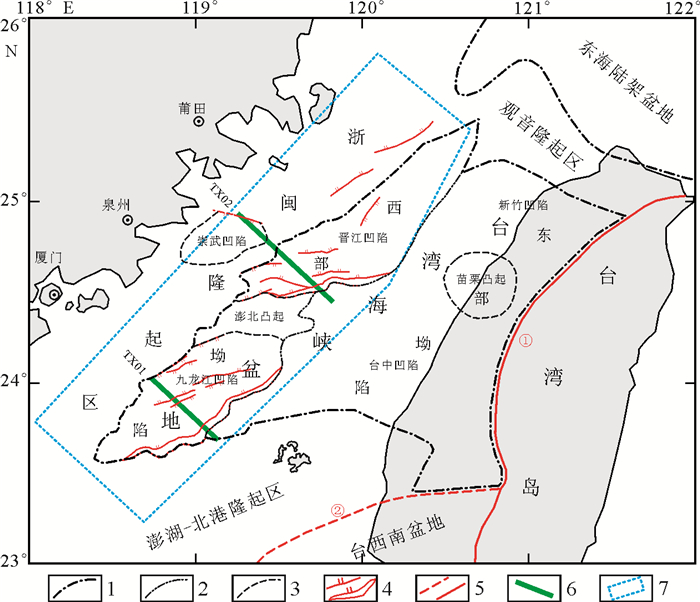
 下载:
下载:
